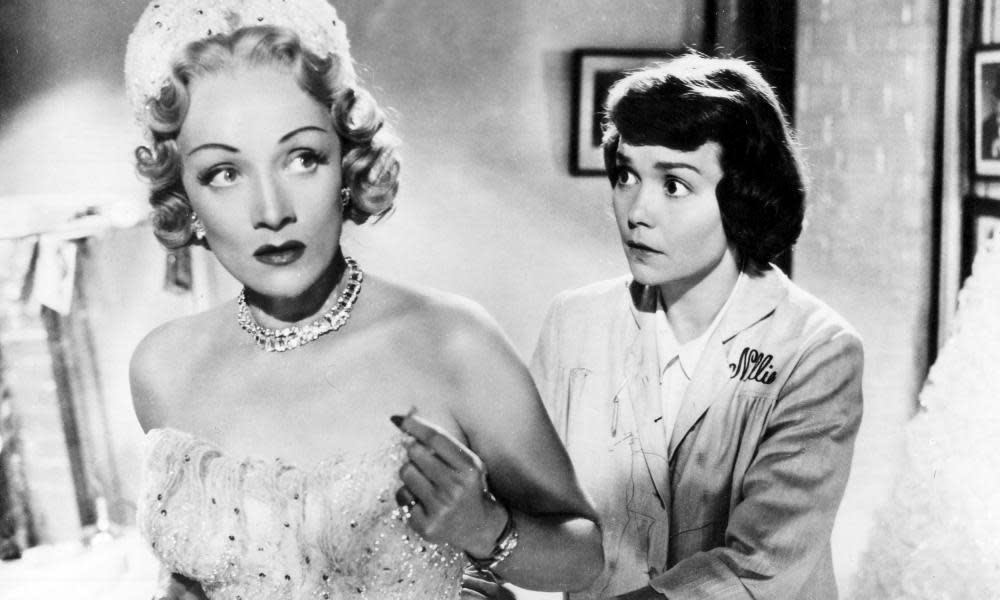Stage Fright: Hitchcock thriller makes theatre a crime scene

Abraham Lincoln’s assassination in his box at the theatre, and the killer’s bid to escape across the stage, is recreated in a whirlwind sequence in DW Griffith’s 1915 epic The Birth of a Nation. The killing of Lincoln, by the actor John Wilkes Booth, is the most famous murder in a theatre but several other films have since built mysteries around deadly crimes committed before a captive audience. Paul Leni’s dazzling The Last Warning (1928) concerns a Broadway actor’s on-stage death. In the British movie Murder at the Windmill (1949), directed by former stage actor Val Guest, a punter is killed during a burlesque show; his body is discovered along with a pipe, an umbrella and a pair of kippers when the theatre is being cleaned.
Murder at the Windmill was filmed in and around the eponymous revue in Soho. It was soon followed by Alfred Hitchcock’s London thriller Stage Fright (1950), partly shot on the other side of Oxford Street, in a playhouse called the Scala and also known as the Prince of Wales theatre but now demolished and not to be confused with either of those existing venues.
For his often comic tale of murder, intrigue and showbiz, based on a novel by Selwyn Jepson, Hitchcock takes full advantage of the location, showing off the Scala’s ornate, marble-pillared auditorium and exploring a warren of backstage corridors and hiding places. At the start of the film there is a close-up of a safety curtain (that name will prove grimly ironic) which lifts to reveal not the stage but a street scene with London landmarks.
Speeding along in a car are two actors, Jonathan and Eve, fleeing from a crime. The husband of leading lady Charlotte Inwood has been murdered. Jonathan is obsessed with Charlotte, Eve loves him, and Charlotte is having an affair with her manager but ultimately admires herself as much as the crowds adore her. These love triangles, which become more like Venn diagrams, involve plenty of role play: Eve assumes the persona of first a reporter and then a maid to protect Jonathan; Charlotte takes on the part of a grieving widow in black (though she says she’d prefer a plunging neckline and something a little more colourful). Eve’s father endeavours to bring some order to these shenanigans as if he is a stage manager.
The Scala is used for the Cole Porter showstopper The Laziest Gal in Town, performed by Marlene Dietrich as Charlotte in a scene that captures much about the whole film. Several times, characters’ mettle is tested when they are performing in public: can they conquer the “stage fright” of these moments? Charlotte stays silkily in control during Porter’s song when she spies a fugitive in the audience. Dietrich drapes herself on a series of divans, dressed in a feathered Dior gown to match the ruffled concentric arcs of a dreamy set design. All around her is a wonder of artifice: theatre as glamorous escapism. This is accentuated by the comparison with a flat-capped stagehand we spot watching from the wings. Hitchcock achieves a similar juxtaposition by casting Dietrich, a Hollywood goddess, alongside a host of British comic character actors including Alastair Sim and Sybil Thorndike as Eve’s parents and Joyce Grenfell as a fairground barker.
Acting, says Eve’s teacher at the Royal Academy of Dramatic Art (Rada), is not “fun and games” but an “extremely difficult” art. The beauty of Hitchcock’s supporting players is that they are experts in having fun, their mirth never quite overpowering the earnestness of Jane Wyman’s Eve or the desperation of Richard Todd’s Jonathan. Another moment of stage fright comes when Jonathan flees the police and hides out in Rada’s Gower Street HQ (another real location), walking into a rehearsal scene to hide in plain sight in Eve’s arms. The director’s daughter, Patricia Hitchcock, studied at Rada and has a cameo as one of Eve’s actor friends.
Hitchcock has his cameo as a passerby when Eve is learning her lines to pose as a maid and dresser to Charlotte. Rather than showing that much of his actor-characters’ stage productions, the director explores the theatricality of crime and justice: the potency of a crime scene and how it can be manipulated; the clamour for a star witness at a trial. His screen trickery even includes a theatrical flourish when a character opens the door to a house and the camera follows him in, with the shot unbroken as the actor simply mimes closing an invisible door behind him.
Is the film frightening? Not really, although there is one bloodcurdling scream that breaks the quiet of the theatre setting. Stage Fright has serious fun with the business of acting, a trade that calls for both the cold, calculating Charlotte and the committed, caring Eve alike to transform into other people. And Hitchcock appreciates the charged atmosphere of an empty theatre, as well as the frisson when the doors are closed, the lights go down and audiences wait expectantly in silence, never knowing quite what will happen next.
• Stage Fright is on Amazon Prime and on DVD.


